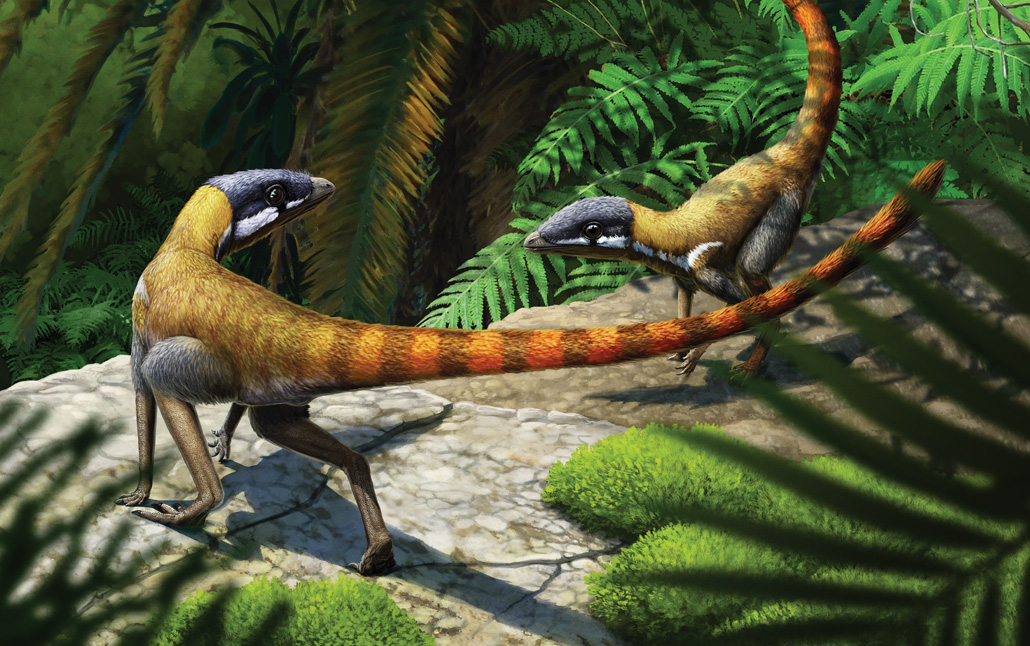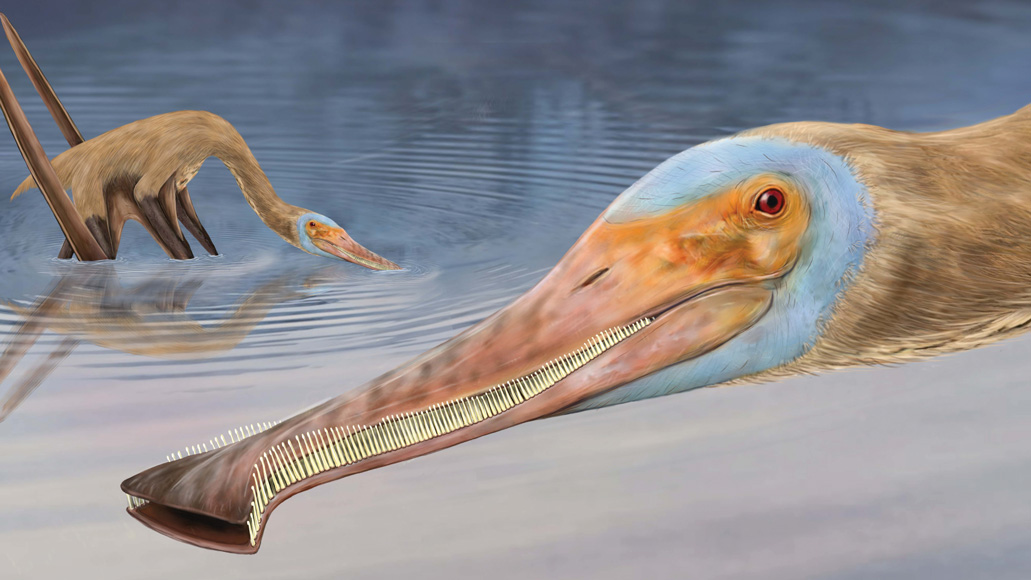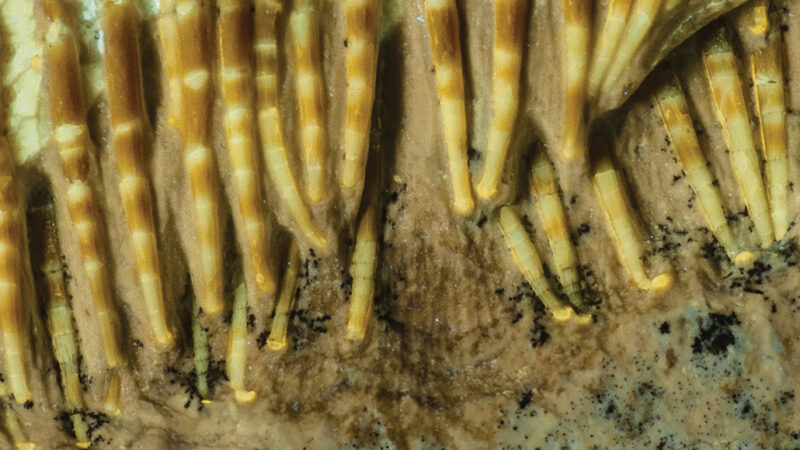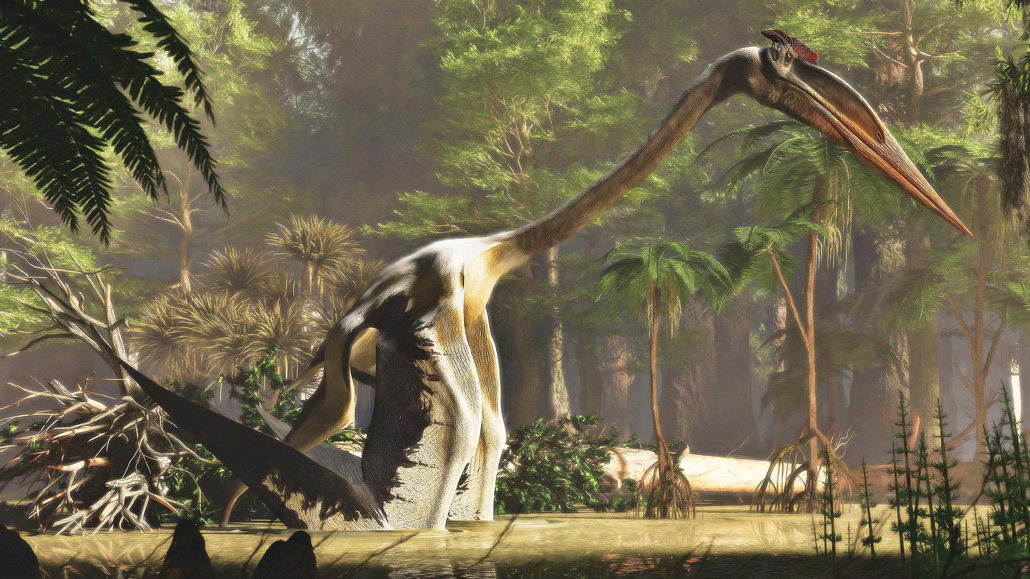New fossils bring the wide world of pterosaurs to life
Ancient fossils hint at where they came from, how they evolved, what they ate and more

The first vertebrates that took to the skies, pterosaurs originated well over 200 million years ago.
Warpaintcobra/iStock/ Getty Images Plus
Share this:
- Share via email (Opens in new window) Email
- Click to share on Facebook (Opens in new window) Facebook
- Click to share on X (Opens in new window) X
- Click to share on Pinterest (Opens in new window) Pinterest
- Click to share on Reddit (Opens in new window) Reddit
- Share to Google Classroom (Opens in new window) Google Classroom
- Click to print (Opens in new window) Print
By Sid Perkins
In an eat-or-be-eaten world, flying has many benefits.
A creature that takes to the skies can more easily escape predators on the ground. It can drop down from above on unsuspecting prey. It can also more easily cover distances quickly to find food and mates.
So it’s kind of surprising that only three groups of vertebrates have ever evolved flight: pterosaurs, birds and bats.
And pterosaurs were the first. They arrived on the scene in Triassic times, perhaps some 237 million years ago. That was at least 70 million years before birds appeared — and more than 180 million years before bats.
Pterosaurs’ name comes from the Greek for “wing lizards.” These flying reptiles eventually spread around the world and ate a huge variety of prey. Some grew bizarre crests atop their heads. Others sported mouths full of teeth that stuck out at odd angles. They ranged in size from creatures that could sit in the palm of your hand to soaring beasts with wingspans as wide as a fighter jet’s.
There were even some that “looked like creatures from your nightmares,” says Brian Andres. He’s a vertebrate paleontologist at the University of Sheffield in England.
In the end, pterosaurs died out for the same reason as the dinosaurs among which they had lived. About 66 million years go, an asteroid wiped out more than 75 percent of all species on Earth. But how pterosaurs first took to the air remains a mystery.
Emerging research is now beginning to offer clues on how pterosaurs came to rule the skies. Paleontologists are learning new details about who the earliest cousins of these aerial artists were and what they looked like. They’re figuring out how pterosaurs evolved from small, flitting creatures into such a hugely diverse group — including the biggest flyer of all time.
Where did pterosaurs come from?
The first pterosaur finds were unearthed in the late 1700s from a limestone formation in Germany. Back then, scientists didn’t quite know what to make of these fossils. One proposed that they came from a weird sea creature. Another thought they had been some kind of missing link in the transition between birds and bats.
Before long, experts settled on the fact that these were flying reptiles — and distinct from dinosaurs.
Pterosaur timeline
Pterosaurs originated during the Triassic Period (about 252 million to 201 million years ago). That was well before the evolution of the other two groups of flying vertebrates — birds and bats. Pterosaurs died out in the same mass extinction that killed off non-bird dinosaurs.
- 237 million years ago: Suspected origin of pterosaurs
- 230 million years ago: Oldest known dinosaur fossil
- 219 million years ago: Oldest known pterosaur fossil
- 150 million years ago: Oldest known bird skeleton
- 66 million years ago: Asteroid hits and pterosaurs, along with non-avian dinosaurs, go extinct
- 52 million years ago: Oldest known bat skeleton
The first species discovered was named Pterodactylus antiquus. This and many discovered soon after were commonly called pterodactyls. But that term officially includes only this species and a small group of related ones. These are part of the broader pterosaur family.
The oldest known pterosaur fossils date to some 219 million years ago. These pterosaurs were already flyers. Paleontologists suspect pterosaurs originated as early as 237 million years ago. (That’s when the oldest and closest relatives of pterosaurs lived. So it’s probably around the time that pterosaurs split off and formed their own line.) But no known fossils show the pterosaurs who first took flight.
Fossils from that early age are scarce, partly because rocks from this period are scarce.
Another reason: Many pterosaur bones were hollow. So they could easily crush after an animal died. “Often, pterosaur remains are just a jumble of bones,” says Matthew Baron. He is a freelance vertebrate paleontologist who lives in Leeds, England.
But there are indirect clues to what the immediate ancestors of the first flyers might have looked like. Those clues come from studies of pterosaurs and their relatives.
In 2020, researchers published a paper in Nature comparing the anatomy of 157 ancient species of early pterosaurs and dinosaurs. They also examined a variety of reptiles living at the same time or earlier.
Pterosaurs’ closest relatives appeared to be a group known as lagerpetids (LAH-gur-peh-tidz). The name comes from the Greek for “rabbit reptiles.” And it refers to the general proportions of the bones in their limbs.
Another study published last year in Nature unveiled a close relative of both these lagerpetids and pterosaurs. Called Scleromochlus taylori, it was a fleet-running reptile that grew only about 20 centimeters (8 inches) long. It could have been the type of animal from which pterosaurs evolved.
S. taylori had slender limbs, small hands and straight claws. All those traits suggest it lived on the ground, says Davide Foffa. A vertebrate paleontologist, he works at National Museums Scotland in Edinburgh.
A critter like S. taylori likely didn’t spend much time in trees. So pterosaurs probably didn’t evolve flight by gliding down from branches. The pelvis of S. taylori also doesn’t look like it was built for leaping off the ground, Foffa says. However, he adds, “it’s not necessary to be a leaper to evolve flight.”

What did pterosaurs eat?
Figuring out what pterosaurs ate often involves a bit of guesswork.
Some fossils preserve stomach contents. They offer direct evidence of an animal’s last meal. But most of the time, researchers find only indirect clues. For instance, they can imagine what a pterosaur ate based on where it lived. Or scientists might compare its body to modern creatures whose diets are known. Such lines of evidence have hinted that various pterosaur species ate everything from insects and worms to fish and crustaceans. Some may even have eaten small land vertebrates.
But other types of evidence, too, help paint the picture of pterosaur diets.
Take Kunpengopterus sinensis (Kun-peng-OP-tur-us Si-NEN-sis). This pterosaur lived some 165 million to 153 million years ago in what is now China. Its fossils recently turned up alongside gastric pellets full of fish scales. (Gastric pellets are bits of non-digested food that modern birds, such as owls, throw up after eating.) Those scaly bits strongly hint that K. sinensis dined on fish.
Still other evidence comes from coprolites — fossilized poop. If ancient dung can be linked to the creature that made it, its contents likely show on what that animal dined, notes Martin Qvarnström. He’s a vertebrate paleontologist at Uppsala University in Sweden.
A few years ago, he was part of a team that analyzed three coprolites extracted from rocks more than 150 million years old. Those rocks, from south-central Poland, also preserved many pterosaur footprints.
One piece of fossilized poop contained many shells of single-celled organisms called foraminifera (For-am-ih-NIF-ur-ah). Another contained bristles from what may have been marine worms. Qvarnström’s team shared its findings in PeerJ in 2019.
For pterosaurs to eat such tiny prey, they must have been filter feeders, like modern flamingos, the team suggests. That would have required jaws full of closely spaced teeth. The filter-feeders from Qvarnström’s study didn’t leave behind any skeletons. Just footprints. So it remains a mystery what they looked like or how big they were.
But maybe they resembled another newly discovered species. This one is called Balaenognathus maeuseri (Bah-LEE-no-NATH-us Ma-ow-SAIR-eye). Its name comes from the Latin for “whale jaw.” Its fossils were found in rocks in what is now Germany. They formed between 157 million and 152 million years ago.

This creature’s wings spanned about 1.25 meters (nearly 4 feet). That would make them similar to a large flamingo’s. This pterosaur also had a bill 10 centimeters (4 inches) long. Shaped like a spatula, this bill sported at least 480 teeth. Long and thin, these teeth were not strong enough to clamp down on struggling prey. But many of these teeth had tiny hooks at their ends. These crochet-hook–like features probably helped the pterosaur filter and trap itty-bitty prey.
Like a flamingo, this long-legged creature probably waded through shallow water in search of lunch. It would have faced the flow and opened its jaws just enough for plankton-rich water to flood in, says David Martill. Then the water would have drained away through the teeth, trapping the food in its mouth. Martill is a vertebrate paleontologist at the University of Portsmouth in England. He and his colleagues described B. maeuseri January 21 in PalZ.

Growing large
How quickly did pterosaurs get big? The discovery of one fossil back in 2017 forced researchers to rethink that timeline. The well-preserved fossil was embedded in rock found on Scotland’s Isle of Skye. It dated back to about 167 million years ago.
This skeleton is missing only parts of its skull, wings, hind limbs and tail, says Natalia Jagielska. She’s a vertebrate paleontologist at the University of Edinburgh. She and her colleagues dubbed the creature Dearc sgiathanach. In Scottish Gaelic, that means “winged reptile from Skye.”
Microscope views of some of this critter’s bones revealed features similar to growth rings in trees. The pterosaur appears to have been at least 2 years old and still growing when it died. Based on the size of the pterosaur’s upper-arm bone, the youngster likely had a wingspan of around 1.9 meters (6.2 feet). Jagielska’s team shared that finding in the February 2022 Current Biology.
These researchers looked at the growth patterns of closely related pterosaurs, too. This gave them an idea of how big an adult D. sgiathanach could have been. The data suggest that their wings would have spanned at least 2.5 meters (8 feet). Trumpeter swans have wings about that big.

Until the discovery of D. sgiathanach, scientists thought pterosaurs stayed small until the late Jurassic Period. That was between about 160 million and 145 million years ago. At that point, pterosaurs would have been competing for food — such as insects — with newly evolved birds. Developing bigger bodies would have helped pterosaurs seek out new things to eat.
But D. sgiathanach evolved tens of millions of years before the first birds flew. So pterosaurs must have faced some other pressure to get big quickly.
Going global
Another recent study speaks to how fast and far pterosaurs spread around the world. Andres and his colleagues recently uncovered pterosaur fragments in Argentina. The bits helped identify two brand-new species. Andres’ team described these fossils March 2022 in Papers in Palaeontology.
The rock where these fossils were found formed between 206 million and 200 million years ago. That rock formed in the southwest of the supercontinent Pangaea (Pan-GEE-uh). Pterosaur remains from around the same time have also emerged in North America, Europe and Greenland. All those areas were then part of northwestern Pangaea.
This suggests that pterosaurs were spread far and wide tens of millions of years earlier than scientists thought.
The largest animal ever to fly
No pterosaur has ever captured imaginations as much as Quetzalcoatlus northropi. This beast was the largest creature to ever fly. A fictionalized version of it even takes down a plane in the film Jurassic Park: Dominion.
Scientists first described the species in 1975. In several 2021 papers, Andres and others built on that early description. For the first time, their work delved deeply into the iconic species’ size, appearance, movements and habitat.
Only a handful of fossils from this species have been found. Most turned up in southwestern Texas. They came from rocks that formed between 69 million and 66 million years ago. That means some of these pterosaurs could have been alive when or just before the dino-killing asteroid struck Earth, says Tom Lehman. He’s a vertebrate paleontologist at Texas Tech University in Lubbock.
Much of what scientists suspect about Q. northropi stems from a related species. Called Q. lawsoni, its fossils are far more common. Enough of its bones exist to reconstruct most of this pterosaur. It appears to have had a wingspan of about 4.5 meters (almost 15 feet). It lived in the same area and around the same time as Q. northropi, Lehman says. But his team estimates that Q. northropi had a much bigger wingspan: perhaps 10 meters (33 feet) or more!

Based on their measurements, the researchers made life-size models of Q. northropi’s bones. These let them see how these monster aerialists would have moved.
“Their back is so short and their legs are so long that they couldn’t walk like other [four-legged creatures],” says Kevin Padian. He’s a vertebrate paleontologist at the University of California, Berkeley. “Their forelimbs are so long, they couldn’t avoid touching the ground.” Yet pterosaur footprints suggest that those forelimbs weren’t helping propel the creature as it walked. They appear instead to have supported it — like walking sticks.
Quetzalcoatlus could reach the ground with its long, toothless beak — and even lower into bodies of water. Once it nabbed prey, it could tilt its beak to the sky, then swallow its victims whole. Padian and his colleagues suggest that this pterosaur patrolled meadows or waded in shallow waters. (This is what modern-day storks and herons do.) There, the creature would have plucked up fish, mammals or even small dinosaurs using its beak like chopsticks.
The sight of a giraffe-sized predator stalking through swamps would have undoubtedly been impressive. “The worst thing about pterosaurs,” Andres says, “is that they’re no longer around.”







